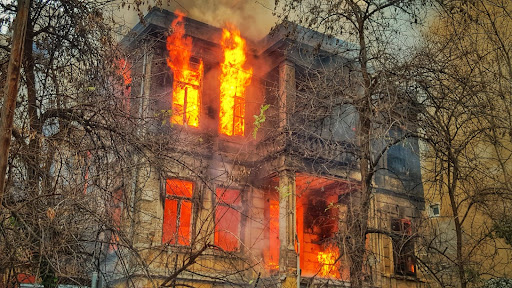Month: November 2021

How to Protect Your Home from a Storm
Storms bring several hazardous conditions to your home, from strong winds to flooding and even the risk of electrical issues. Insight Restoration can help repair your home from storm damage, but prevention is key. Here are some ways you can protect your home if you know a storm is on the way.
Pre-Repair
An already damaged home is more susceptible to additional storm damage. Loose shingles and siding can more easily be ripped away in a strong gust, and missing ones let in rain and snow. Getting your roof and siding repaired or replaced ensures that your home has the structural integrity to withstand more storms.
Also, clear out your gutters to prevent any water backing up from heavy rain. And make sure your sump pump is functioning in case of flooding. Finally, check for any loose or untethered yard supplies, such as fences or tree branches. If you want your home to survive a storm, make sure it’s in tip-top condition before the storm comes around.
Add Additional Support
A strong home is a good starting point, but adding additional safety measures will keep it sturdy. Board up your windows to protect the inside of your house from broken glass, rain, and any wind-swept objects. This is especially crucial if you are staying in your home during the storm, as unprotected windows can cause serious injuries to you and your family.
Sandbags are a great way to prevent flooding, and most local municipalities offer them before a storm, especially in locations where hurricanes and tornadoes are most common. Placing sandbags around your outside doors and low windows will divert flooding from your house. You’ll especially want to get sandbags if your home doesn’t have a sump pump or it’s not in working order.
Double-Check Security and Hazard Alarms
Storms cause more than just flooding. Strong winds and lightning can knock out power or even start fires. Making sure your security features are current and functioning is vital to keeping you and your house protected.
A lot of fire alarms and other hazard detectors run on electricity, so having battery-powered backups with fresh batteries can save you and your home in case of a power outage. It’s essential to have a working carbon monoxide detector during a storm if you are using a generator to keep home essentials running. Generators produce carbon monoxide, and if you have everything boarded up to prevent flooding, you’ll want advance notice if the CO2 levels are getting too high in your house.
A decent-sized storm can wreak havoc on your life and your property. With proper prevention, you can reduce the damage that these storms cause. But not all damage can be avoided. If your home has recently suffered through a storm in North Idaho’s Bonner, Boundary, and Kootenai Counties, call Insight Restoration today at (208) 427-2825 for a fast response and quality storm damage cleanup and restoration.

First Steps After a House Fire
Experiencing a house fire is terrifying, and facing the aftermath of it is daunting. There’s a lot that can happen to your house because of fire damage, no matter how small or contained the fire was. Being proactive in your approach after a fire is the best way to ensure you have a speedy and painless restoration, and one that’s hopefully covered by your insurance. By completing the following steps as soon as possible, you’ll help your house recover from a fire as if it never happened.
Get a Copy of the Fire Report and Have Your Home Inspected
When firefighters put out a fire, they always make a detailed report. The report includes the size and severity of the fire, the location of the fire, and the initial survey of the damage caused. You can call your local fire department for this information.
Afterward, you’ll want to have your home properly inspected. Firefighters are trained to put out fires, not necessarily to catalog all the damage. Your local fire department will provide you with a list of qualified inspectors, but you can also get an inspection and report from a fire restoration company that will provide a quote on how much it will cost to restore your home.
Contact Your Insurance Company
After you have the initial reports and inspections on your home, call your insurance company to report the file and open a claim. With all the information on hand before you call, you’ll be able to expedite the process and get answers about your policy faster. Most insurance companies cover house fires no matter the cause, but the amount paid out may differ.
If you’re unsure about what your policy covers, call your insurance adjuster before the inspection. There may be specific things you’ll need to have examined to help support your claim.
Protect Your Home
Depending on the scale of the fire damage, you may need to take extra precautions to keep your home safe after a fire, especially if you can’t stay in the house during repairs. There are several ways your house can be exposed to further damage after a fire, so any broken windows or other destroyed openings to your home should be boarded up and covered. This will keep out unwanted guests and environmental hazards such as rain or snow. You can also call your local police department and ask them to check on the house periodically.
Protecting your home also includes proactively getting ahead of the damage caused by the fire before repairs begin. Keeping windows and doors open while you’re on the site will help clear out any smoke damage, and the fresh air and cross breeze can help keep on top of water damage from the fire department’s hoses.
When your house sustains any kind of damage, restoring it can be a hassle. But if you stay on top of the work and gather all the information you need ahead of time, you can breeze through the insurance process and get started on repairs sooner. If your home was recently damaged in a fire, call Insight Restoration today at (208) 427-3042. Our certified and experienced technicians are ready to help you get your home back to working condition.

Steps to Keep Your Home Safe While Saving for Repairs
Home repairs can be expensive, both in time and money. But the longer your home goes without repair, the more damage it’s likely to sustain. Insight Restoration is available 24/7 to help you with repairs, but you may not always be able to fix your home up right away. There are a few steps you can take to prevent further damage to your home and help make tarp and board clean-up a breeze.
Board Up and Use Tarps
The best way to protect your home while saving or waiting for repairs is to utilize boards and tarps for external damage. Smashed windows can be remedied with plastic and tape. Carefully remove any shards of glass and then cover the window with a sheet of plastic, using tape to secure the edges. Test the hold with a hose first to make sure the seal is tight enough to prevent leaking. If you live in a particularly cold area, use layers of bubble wrap between the plastic and the window to help with insulation. Smaller cracks can be temporarily fixed with glue or clear nail polish.
More extensive breaks may need to be tarped or boarded up with wood. Larger openings in the side of your house can be temporarily fixed with plywood, nailed down to prevent strong winds from adding more damage. A tarp between the wood and the wall will also help prevent water and other environmental hazards from getting in. Tarps and boards can also be used on your roof to prevent further damage caused by missing or loose shingles.
Take Notes for Insurance
Even if you have homeowners’ or renters’ insurance, it can take a while for your claim to go through and even longer to get the money you need to make repairs. Keeping a detailed list of the damages in your home and yard will help the process move along. Depending on your policy, insurance may even cover damages that accumulate because of repair time.
When waiting to get your home repaired, take pictures of the damages you find as soon as you find them. For each one, make a note of what the damage is, how extensive, and when it was noted. Damages that are related to the initial problem could be covered, even if they were found days or weeks after the incident.
Waiting for time or money to repair your home can lead to further damage, but by properly boarding up and utilizing tarps, you can lessen its impact on your house. Keeping detailed notes with photos for insurance can also help reimburse you for damages incurred while waiting.
If you need home repairs or materials, call Insight Restoration at (208) 427-2962 for quick and reliable service. And when our certified and experienced technicians finish repairing your home, we can even help with a quick and easy tarp and board clean-up.

When to Know it’s Time to Unhoard
Hoarding is a struggle a lot of people deal with for a variety of reasons. Some hoard because they can’t let go of sentimental items. Others do so because they would rather have and not need than need and not have. Some become accidental hoarders when they don’t have as much time to clean and declutter as their home needs. Whatever the reason may be, hoarding is a serious problem that can lead to severe issues, including health and safety concerns. But how do you tell the difference between saving and hoarding? When do you know it’s time to have professional hoarding removal done?
You Find Yourself Anxious at Home
Often, hoarding spills out from just one room of the house, taking over most of the space. When you are surrounded by all of that clutter, especially if you are aware of how much it is, you can start to feel anxious and worried in your own home. If you find yourself feeling on edge when you’re at your house, or you look for any reason to avoid being at home, it may be time to consider hoarding removal services.
Things Keep Going Missing
There is no way to properly organize a hoarding problem. “A place for everything and everything in its place” only goes so far when you have practically everything in your house. When a home is overtaken by a hoarding problem, you’ll find that things go missing very easily, even if you have an organization system in place. You may have a specific section of your house where you keep all your favorite sweaters, but if you have a hundred of them, finding the specific one you’re looking for is like finding a needle in a haystack. If you constantly find yourself digging through piles to find something you need, you may have a hoarding issue.
You Have Items That Serve No Purpose
It’s one thing to be prepared for what you might need, and it’s another to be prepared for everything. Holding on to items that may be useful in the future is a good idea and can be a great way to save money from having to buy them when needed. But not every item you keep is going to be helpful. Maintaining a collection of extension cords, wires, and other connections saves headaches when trying to hook up new devices or when moving them around. But if all of your devices have HDMI cables, there’s no need to hang on to the RCA cables. If you find that you are holding on to items that don’t make sense for what’s in your home, you should consider getting rid of them.
Building a hoard in your home is easy and sometimes goes unnoticed. Removing the hoard is much easier said than done. Luckily, you don’t have to go it alone. Call Insight Restoration today at (208) 427-2825 for help with hoarding removal and clean-up.

